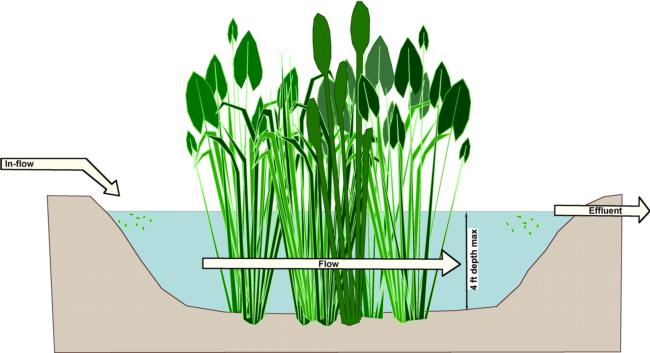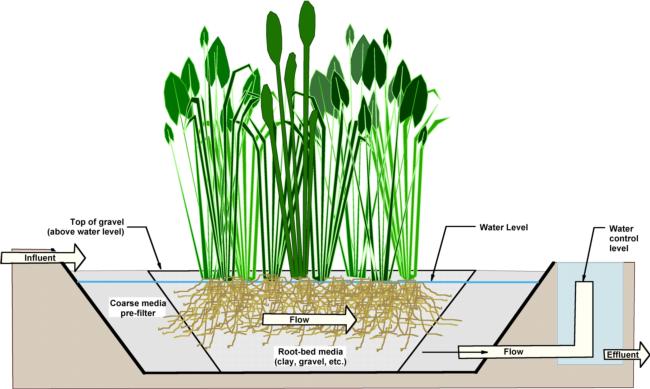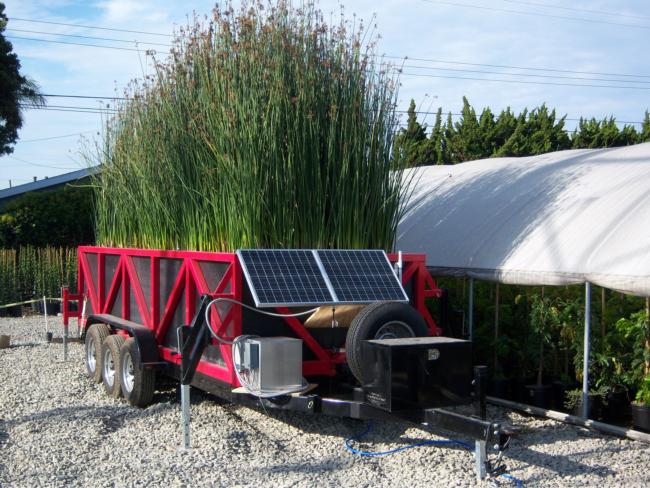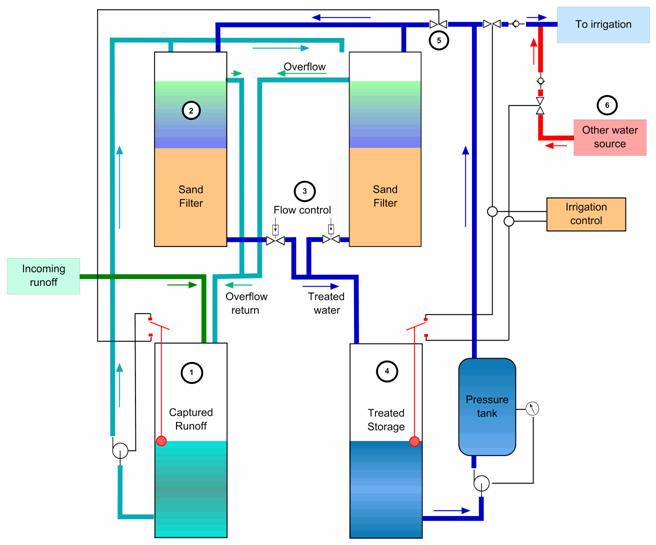Ecological approaches used in nurseries to treat water
by Lorence R. Oki and Sarah A. White
Growers face increasing pressure to remediate and treat runoff, both to reduce deterioration of surface and ground water quality and also to facilitate conservation through recycling and reuse of this vital resource. Many nurseries and greenhouses are implementing water and nutrient management plans to manage inputs and runoff, to save money and to comply with regulations. These plans may include treatments based on chemical, thermal, or radiation methods (e.g., chlorine, pasteurization and UV, respectively) to remove contaminants and pathogens from runoff. Certified organic growers and growers with an eye toward future sustainability need alternatives to chemical treatment to manage and recycle runoff. In recent years, many researchers have focused on various alternative methods for remediating pesticide, nutrient and biological contaminants from irrigation water. Two effective, research-based ecological alternatives for removing various contaminants from runoff are constructed wetlands (CWs) and slow sand filtration (SSF).
Nutrient and Pesticide Contaminants
Residential, urban and agricultural land uses contribute to nonpoint source runoff. Excess nitrogen and phosphorus in runoff can lead to increased rates of eutrophication. Eutrophication can be a stable, naturally occurring process in surface waters. However, water bodies with communities of organisms adapted to low nutrient concentrations (e.g., phosphate levels < 0.05 milligrams per liter [mg/L] PO4-P) are more susceptible to overfertilization whereas naturally eutrophic water bodies are more resilient to additional nutrients because their plant and animal communities are adapted to the more productive environment. Nutrient enrichment and algal blooms occur when the natural balance of an aquatic system is upset.
Pesticide release from both agricultural and residential sources is well documented. Many commonly used pesticides have detrimental effects on organisms from microbes to larger fish species living in creeks, streams and rivers. For example, the pyrethroid pesticide bifenthrin affects Hyallela azteca, a benthic amphipod, at concentrations as low as 1 to 3 parts per trillion (ppt). Similarly, the degradation products of fipronil, a fairly new phenylpyrazole pesticide, affect bluegill sunfish (Lepomis macrochirus) at concentrations between 20 and 25 parts per billion (ppb).
Local, state and federal environmental agencies are under pressure to limit pollutant discharges from identifiable nonpoint source contributors to further protect and improve water quality (Taylor et al. 2006, Calvo-Bado et al. 2003). Agricultural nonpoint sources can include greenhouse and nursery operations that do not capture and recycle runoff. Currently, California, Florida, Maryland, Oregon and Texas have adopted regulations mandating runoff capture or control by irrigated agricultural operations. Similar regulation in other states is likely as efforts continue to protect and maintain the quality of surface and ground water resources. In fact, in January of 2009, the US Environmental Protection Agency in concert with the Florida Department of Environmental Protection proposed an expedited schedule for establishing numeric nutrient criteria limiting nitrogen and phosphorus pollution in Florida lakes, rivers, streams, springs and canals (US Environmental Protection Agency 2010). This precedent could set the stage for regulations in other states in the next decade. California has implemented the Irrigated Lands Regulatory Program which controls runoff from all irrigated agricultural operations, including nurseries and greenhouses, in the State.
Pathogens and Biological Contaminants
Irrigation and runoff water can be infested with a variety of pathogens, and the risk of disease increases when water is recycled. All major pathogen types— fungi, water molds, bacteria, viruses, and nematodes— have been shown to be transmitted via recycled water. Of major concern are waterborne phytopathogens (Phytophthora, Pythium, etc.), which are perennial problems across all facets of agriculture and are responsible for billions of dollars of crop losses. Moreover, recycled water may contain high levels bacteria. A University of Florida survey of 24 greenhouse and nursery growers throughout the United States found that bacterial load in 76% of all recycled irrigation waters sampled exceeded the levels needed to avoid clogging of water-conserving drip irrigation systems. A number of chemically based treatment methods have proved effective in controlling or reducing disease incidence and clogging of irrigation lines due to biofilms. Drawbacks to chemically based treatment systems include high initial investment costs, continuous operational expenses, worker safety issues and a potential for environmental harm if not properly managed.
Overview of Alternative Treatment Options
In recent years, many researchers have focused on alternative methods for treating pathogens as well as remediating pesticide and nutrient contaminants from recycled water and runoff. These alternative methods facilitate the breakdown and removal of pollutants using biological processes that avoid the hazards associated with chemical-based systems. There are a variety of ecologically based treatment options that are applicable to nursery operations. Constructed wetlands enable both small and large green industry operations to maintain water quality levels necessary for successful crop growth while potentially facilitating the future use of alternative water sources. Nursery operations limited in production space and land expense may find the small-scale treatment systems, including mobile/portable wetlands and sand filtration systems, to be more effective.
Large-Scale Ecological Treatment Systems
Wetlands are considered the “kidneys” of the landscape because of their capacity for cleansing polluted waters. Constructed wetlands have been used for decades, mostly to treat domestic or municipal sewage, focusing on reducing nutrients, suspended solids, heavy metals and human pathogens. Success in cleansing municipal and industrial point-source discharges led to the widespread use of CWs to treat many other types of wastewater, including industrial and agricultural wastewaters, acid mine drainage, landfill leachate and stormwater runoff.
There are various types of CWs: free water surface (surface flow), subsurface flow (horizontal and vertical flow), mobile, and floating vegetation wetlands. Surface flow and subsurface flow CWs are most commonly used to treat agricultural wastewater and are described below. Mobile/portable wetlands are small-scale treatments and are described in the next section.
Surface flow constructed wetlands. A surface flow CW resembles a shallow (0.5 to 2.5 feet) freshwater marsh and generally requires a large land area for wastewater treatment (fig. 1). A five-year study funded as part of the USDA-ARS Floriculture and Nursery Research Initiative and conducted by researchers at Clemson University examined the nutrient-removal capacity of a 9.31-acre surface flow CW receiving runoff from 120 acres of container production at a large nursery in Cairo, GA. The CW was highly efficient at removing nitrogen (nitrate, nitrite and ammonia) from nursery runoff from mid-spring through late fall in the southeastern United States, although it failed to consistently lower phosphorus levels. These CWs may also include vegetation on floatation devices. This vegetation facilitates biological processes that breakdown pollutants in the water.

Fig. 1. Surface flow wetland designed for treating nutrient rich runoff from agricultural production areas. Image Sarah White.
Surface flow CWs work best for high to moderate runoff volumes, and should be designed to retain water for 3 to 3.5 days. The recommended surface area can be reduced if depth is increased (typical depth is 2 to 3 feet, maximum depth is 4 feet), which promotes anaerobic (low oxygen) conditions that facilitate nitrogen removal.
Subsurface flow constructed wetlands. Subsurface flow CWs utilize a smaller “footprint” than surface flow CWs and can remediate both nitrogen and phosphorus if properly designed. A subsurface flow CW consists of a lined or impermeable basin filled with a 2-foot-deep layer of coarse medium pea gravel with a high hydraulic conductivity and wetland plants (fig. 2). Wastewater flows horizontally or vertically below the surface of the media to prevent exposure to humans or wildlife; remediation is aided by plants and associated microbial populations.

Fig. 2. Horizontal, subsurface flow wetland schematic, with design considerations for treatment of nutrient-rich agricultural runoff. Image Sarah White.
Subsurface flow CWs are better for winter treatment than surface flow CWs and emit less total ammoniacal nitrogen (NH3-N and NH4+-N) to the atmosphere. The gravel substrate of subsurface flow CWs is costly, and treatment longevity is finite because substrate clogging may occur after several years of operation.
Mixed system constructed wetlands. When phosphorus treatment is needed, simply passing water through a surface flow CW is not adequate. A mixed system, using a surface flow CW for nitrogen removal and subsurface flow CW for phosphorus, may be the most effective treatment option. When targeting phosphorus, instead of pea gravel, the subsurface flow CW substrate should be a pre-screened fired-clay nugget, such as Oil-Dri Agsorb. Lab verification of phosphorus-binding capacity is necessary to insure adequate treatment capacity. The clay nuggets used should be large enough to prevent clogging and to allow water infiltration and movement. Phosphorus-removal efficiency declines as binding sites fill, so monitoring is necessary to determine when to replace the clay nuggets. These secondary treatments can be greater than 80% efficient in reducing phosphorus concentrations in discharge.
Small-Scale Treatment Systems
Mobile/Portable CWs. A portable subsurface flow CW system was developed by Mobile Environmental Solutions Inc., Tustin, CA (fig. 3). The “portable wetland” uses bulrush (Schoenoplectus spp.) planted in a lightweight medium of 3/8-inch pumice. Inflow and outflow pipes manage the movement of water in this self-contained system, which can be transported by a midsized pickup truck.

Fig. 3. Portable subsurface flow wetland established with bulrush, water moves through the wetland via a solar-powered pump. Image Jim Welsh.
Slow Sand Filtration. Slow sand filtration (fig. 4) is a biological treatment method that has been in use for centuries to produce drinking quality water. The filter consists of a bed of sand through which contaminated water slowly passes. A biofilm develops on the surface of the sand grains and is responsible for the removal of pathogens and other pollutants that may be in the water.
This treatment method is sometimes confused with rapid sand filtration, so a description of the two methods will be used to show the differences. Water passes through the sand media in both methods and that’s the only commonality among these filtration methods.
Rapid sand filters provide physical filtration, utilizing sand grains larger than 1 millimeter (mm) in diameter, resulting in a high treatment capacity of 18 to 180 gallons per minute (gmp) per square yard of sand bed surface area. Since this filtration is physical, these filters don’t remove pathogens or pollutants that are dissolved in the water. Rapid sand filters require frequent cleaning using a backwashing procedure. This process can be automated when backpressure reaches a threshold determined by the operator.
Slow sand filters are a biological treatment method that facilitates formation and maintenance of biofilms that form on sand grains. To avoid packing, the sand grains must be round, not sharp, and to maximize surface area they are about 0.3 mm in diameter (about 60 mesh). The sand must stay submerged at all times and the sand bed surface must not be disturbed. The recommended depth of the sand bed is 3 feet and is constructed over a drainage system to collect the treated water.
As water is treated, a thick film, or “schmutzdecke,” will develop on the bed surface. Over time this film becomes thickened and restricts water flow through the filter so that desired flow rates cannot be maintained. At that point, the sand bed needs to be cleaned by draining water to expose the sand bed surface and the top 2- to 3-inch layer of sand and schmutzdecke is removed. The sand bed is then resubmerged and “reconditioned” for 24 hours before treatment resumes.
The water flow rate through the sand filter should be about 800 gallons per day (gpd) per square yard of sand bed surface area. This flow rate is used to determine the size of the filters required. For example, to treat 50,000 gallons of captured runoff per day, two sand beds constructed in 20-foot diameter tanks, totaling 628 square feet, would be needed. The slow sand filters are one part of a water treatment system (fig 4). The other components are similar to other treatment systems. However, because the treatment flow rates are low and rely on biological constituents, water must flow continuously through the sand bed. Since the pores between the sand grains are very small, water that is high in particulates can accelerate the treatment frequency due to plugging. So, removal of these particulates from the water prior to treatment through the sand beds would promote longer intervals between servicing.

Fig. 4. Slow sand filtration system and operation. Image Loren Oki.
1. Captured runoff is stored. A float monitors the water level. If runoff is present, it is pumped into the sand filters.
2. A 3-foot water depth is maintained over the sand bed. Overflow returns to the captured runoff storage tank.
3. Flow is controlled to maintain the required rate.
4. Treated water is stored for use. A float monitors water level. If treated water is present, it is used for irrigation.
5. If there is no runoff to be treated, treated water is pumped back to the filters to maintain the water level over the sand bed.
6. If there is no treated water available, water from an alternate source is used for irrigation.
Research at the University of California, Davis funded as part of the USDA-ARS Floriculture and Nursery Research Initiative has shown that higher than optimal flows can only be maintained for a short period. At high flow rates, filters plug more quickly and thus require more frequent monitoring and maintenance. Slower flow rates ensure that the filters perform optimally with longer intervals between maintenance.
Other research at UC Davis demonstrated that filters established against a specific pathogen can be effective in treating water that contains other pathogens. Sand filters were established using captured runoff inoculated with Phytophthora capsici for 30 days. When stream water containing a mixture of several other Phytophthora species was introduced to the filters, all of the pathogens were removed. Other studies have identified organisms in the biofilms that produce cellulose, amylase, chitinase and biosurfactants (Calvo-Bado et al. 2003). Work is underway to further characterize the components of the biofilms. Future work will also examine the efficacy of slow sand filters to remove plant viruses and plant pathogenic nematodes from captured runoff.
Research is underway to examine pairing slow sand filters with other treatment systems such as mobile/portable CWs. For the nursery and greenhouse industry, slow sand filtration coupled with CWs offer producers an ecologically based approach for treating runoff containing nutrients, pesticides, pathogens and other organic and biological contaminants. These treatment technologies can be used to recycle water or to assure compliance with increasingly stringent environmental regulations regarding the discharge of nonpoint-source pollutants.
References
Taylor MD, White SA, Chandler SL, Klaine SJ, Whitwell T. 2006. Nutrient management of nursery runoff water using constructed wetland systems. HortTechnology 16:610-614.
US Environmental Protection Agency. 2010. Water quality standards for the state of Florida's lakes and flowing waters. January 2010 Fact Sheet.
California Environmental Protection Agency. State Water Resources Control Board. Irrigated Lands Regulatory Program. http://www.swrcb.ca.gov/water_issues/programs/agriculture/. (accessed Sept. 13, 2010).
Calvo-Bado LA, Pettitt TR, Parsons N, Petch GM, Morgan JAW, Whipps JM. 2003. Spatial and temporal analysis of the microbial community in slow sand filters used for treating horticultural irrigation water. Applied & Environmental Microbiology 69:2116-2125.
Fisher, P.R., R. Raudales, D.P. Meador. 2010. How Clean Is Your Water? Choosing a Water Treatment System. OFA Bull. July/August 2010: 4-7.
Lorence Oki is a UC Cooperative Extension Landscape Horticulture Specialist, Department of Plant Sciences, UC Davis and Sarah White is a Nursery Extension Specialist, Environmental Horticulture Department, Clemson University.












